Related Research Articles
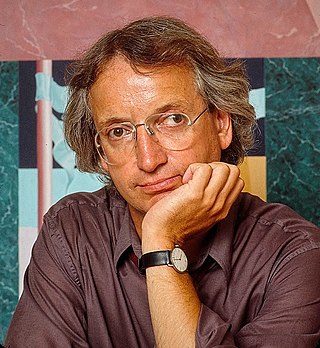
Michael Graves was an American architect, designer, and educator, and principal of Michael Graves and Associates and Michael Graves Design Group. He was a member of The New York Five and the Memphis Group and a professor of architecture at Princeton University for nearly forty years. Following his own partial paralysis in 2003, Graves became an internationally recognized advocate of health care design.

Peter David Eisenman is an American architect, writer, and professor. Considered one of the New York Five, Eisenman is known for his high modernist and deconstructive designs, as well as for his authorship of several architectural books. His work has won him several awards, including the Wolf Prize in Arts.
John Seward Johnson II, also known as J. Seward Johnson Jr. and Seward Johnson, was an American artist known for trompe-l'œil painted bronze statues. He was a grandson of Robert Wood Johnson I, the co-founder of Johnson & Johnson, and of Colonel Thomas Melville Dill of Bermuda.
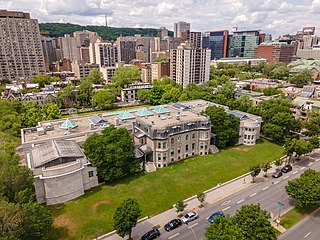
The Canadian Centre for Architecture is a museum of architecture and research centre in Montreal, Quebec, Canada. It is located at 1920, rue Baile, between rue Fort and rue Saint-Marc in what was once part of the Golden Square Mile. Today, it is considered to be located in the Shaughnessy Village neighbourhood of the borough of Ville-Marie.

The Wexner Center for the Arts is the Ohio State University's "multidisciplinary, international laboratory for the exploration and advancement of contemporary art."

The Memorial to the Murdered Jews of Europe, also known as the Holocaust Memorial, is a memorial in Berlin to the Jewish victims of the Holocaust, designed by architect Peter Eisenman and Buro Happold. It consists of a 19,000-square-metre (200,000 sq ft) site covered with 2,711 concrete slabs or "stelae", arranged in a grid pattern on a sloping field. The original plan was to place nearly 4,000 slabs, but after the recalculation, the number of slabs that could legally fit into the designated areas was 2,711. The stelae are 2.38 m long, 0.95 m wide and vary in height from 0.2 to 4.7 metres. They are organized in rows, 54 of them going north–south, and 87 heading east–west at right angles but set slightly askew. An attached underground "Place of Information" holds the names of approximately 3 million Jewish Holocaust victims, obtained from the Israeli museum Yad Vashem.
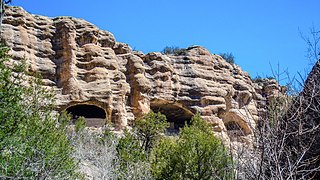
Gila Cliff Dwellings National Monument is a U.S. National Monument created to protect Mogollon cliff dwellings in the Gila Wilderness on the headwaters of the Gila River in southwest New Mexico. The 533-acre (2.16 km2) national monument was established by President Theodore Roosevelt through executive proclamation on November 16, 1907. It is located in the extreme southern portion of Catron County. Visitors can access the monument by traveling northbound from Silver City, New Mexico, 45 miles (72 km) on NM 15.

The linear city is an urban plan for an elongated urban formation that was proposed by Arturo Soria y Mata in 1882. The city would consist of a series of functionally specialized parallel sectors. Generally, the city would run parallel to a river and be built so that the dominant wind would blow from the residential areas to the industrial strip. The sectors of a linear city would be:
- a purely segregated zone for railway lines,
- a zone of production and communal enterprises, with related scientific, technical and educational institutions,
- a residential zone, including a band of social institutions, a band of residential buildings and a "children's band",
- a park zone,
- an agricultural zone with gardens and state-run farms.

The Como Park Zoo and Marjorie McNeely Conservatory are located in Como Park at 1225 Estabrook Drive, Saint Paul, Minnesota. The park, zoo and conservatory are owned by the City of Saint Paul and are a division of Saint Paul Parks and Recreation. Its attractions include the zoo, the conservatory, an amusement park, a carousel, Lake Como, a golf course, a pool and more. The park receives more than 1.9 million visitors annually. Como Park is a free park and while no admission fee is charged for the zoo or conservatory, voluntary donations of $4 per adult and $2 child are suggested.
The New York Five was a group of architects based in New York City whose work was featured in the 1972 book Five Architects. The architects, Peter Eisenman, Michael Graves, Charles Gwathmey, John Hejduk, and Richard Meier, are also often referred to as "the Whites". Other architects and theorists have been associated with the group, including Werner Seligmann, Kenneth Frampton, Colin Rowe, and Gwathmey's partner Robert Siegel.

Anna Vaughn Hyatt Huntington was an American sculptor who was among New York City's most prominent sculptors in the early 20th century. At a time when very few women were successful artists, she had a thriving career. Hyatt Huntington exhibited often, traveled widely, received critical acclaim at home and abroad, and won multiple awards and commissions.

Robert Eisenman is an American biblical scholar, historian, archaeologist, and poet. He is currently professor of Middle East religions, archaeology, and Islamic law and director of the Institute for the Study of Judaeo-Christian Origins at California State University Long Beach.

Deconstructivism is a postmodern architectural movement which appeared in the 1980s. It gives the impression of the fragmentation of the constructed building, commonly characterised by an absence of obvious harmony, continuity, or symmetry. Its name is a portmanteau of Constructivism and "Deconstruction", a form of semiotic analysis developed by the French philosopher Jacques Derrida. Architects whose work is often described as deconstructivist include Zaha Hadid, Peter Eisenman, Frank Gehry, Rem Koolhaas, Daniel Libeskind, Bernard Tschumi, and Coop Himmelb(l)au.

A linear settlement is a settlement or group of buildings that is formed in a long line. Many of these settlements are formed along a transport route, such as a road, river, or canal. Others form due to physical restrictions, such as coastlines, mountains, hills or valleys. Linear settlements may have no obvious centre.

The Greater Columbus Convention Center (GCCC) is a convention center located in Downtown Columbus, Ohio, United States, along the east side of North High Street.
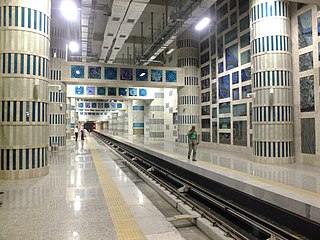
Yenikapı is a port and a quarter in Istanbul, Turkey, in the metropolitan district of Fatih on the European side of the Bosphorus, and along the southern shore of the city's historically central peninsula.

Nicole Eisenman is a French-born American artist known for her oil paintings and sculptures. She has been awarded the Guggenheim Fellowship (1996), the Carnegie Prize (2013), and has thrice been included in the Whitney Biennial. On September 29, 2015, she won a MacArthur Fellowship award for "restoring the representation of the human form a cultural significance that had waned during the ascendancy of abstraction in the 20th century."

Double Check is a 1982 sculpture by John Seward Johnson II, located across from Zuccotti Park at the corner of Liberty Street and Broadway in Manhattan, New York City. The bronze sculpture portrays a well-dressed businessman sitting with his briefcase open, which are filled with office materials getting ready to enter an office building. The statue is notable for its association with the 9/11 attacks.
Grounds For Sculpture (GFS) is a 42-acre (170,000 m2) sculpture park and museum located in Hamilton, New Jersey. It is located on the former site of Trenton Speedway. Founded in 1992 by John Seward Johnson II, the venue is dedicated to promoting an understanding of and appreciation for contemporary sculpture by organizing exhibitions, publishing catalogues, and offering a variety of educational programs and special community events.
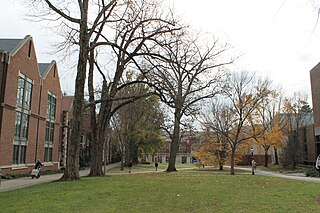
Princeton University School of Architecture is the name of the school of architecture at Princeton University. Founded in 1919, the School is a center for teaching and research in architectural design, history, and theory. The School offers an undergraduate concentration and advanced degrees at the master's and doctoral levels.
References
- ↑ Brasuell, James (2014-11-29). "Renewing the Idea of a Linear City". Planetizen.
- ↑ Jacobs, Karrie (2020-08-21). "The Linear City by Peter Eisenman and Michael Graves". dwell.
- ↑ "Linear City". Hidden Architecture. 2016-06-05. ISSN 2530-8904.
- ↑ "Grounds For Sculpture is exhibiting a 50-year retrospective of Michael Graves' work". WHYY. Retrieved 2024-02-13.